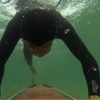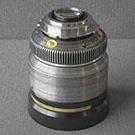-
Posts
1,148 -
Joined
-
Last visited
Reputation Activity
-
 tupp got a reaction from sunyata in Linux everything! Who's Interested?
tupp got a reaction from sunyata in Linux everything! Who's Interested?
Not really.
Yes. This is the typical FUD scenario -- early adopter of Red Hat, then got disinterested. I've never used Red Hat.
That's fine. I would rather have open source and free software.
Disagree wholeheartedly. With open source and free software, I can do almost anything that can be done with proprietary software. Furthermore, open source software often can do more than proprietary software, as a lot of the innovation occurs in open-source code.
I would rather use software from a coder who is enthusiastic than from one who is merely drawing a paycheck.
-
 tupp got a reaction from JurijTurnsek in Linux everything! Who's Interested?
tupp got a reaction from JurijTurnsek in Linux everything! Who's Interested?
A Linux beta of Resolve 12 is available as a free download.
-
 tupp got a reaction from IronFilm in Linux everything! Who's Interested?
tupp got a reaction from IronFilm in Linux everything! Who's Interested?
A lot of the innovation in software happens in open source projects in which there is a lot of input and freedom to experiment. On the other hand, some popular proprietary apps have enthusiastic users contributing novel plug-ins.
I don't think that there is much lacking in open-source imaging/production software, and there are also proprietary options for Linux/BSD.
-
 tupp got a reaction from Zach Goodwin in Gear Upgrade: Buy Canon 70D or more lenses for t3i?
tupp got a reaction from Zach Goodwin in Gear Upgrade: Buy Canon 70D or more lenses for t3i?
I would spend my money on used lenses. Lenses with Nikon F mounts are ideal becuase they can be adapted to many cameras (and actual Nikkor glass is usually a good value, too).
One little known advantage of the T3i -- it is one of the few cameras that has a Tragic Lantern build.
Tragic Lantern allows control of the h264 GOP (group of pictures) setting, so one can shoot h264 with all I-frames. In this scenario, each frame is essentially its own jpeg picture, with none of the blocky interframe artifacts that often plague h264 encondings.
Here's an article that further explains things. As mentioned in this article, the early "TL 1" build for the T3i/600D allows more control of the h264 settings than the later builds.
With both Tragic Lantern and Magic Lantern, one can also boost the h264 bit rate to one's liking.
I think that the 5D mkIII is the only Canon HDSLR that offers "out-of-the-box" h264 with all I-frames. Don't know whether or not Canon offers any control of h264 bit rate on the 5D mkIII.
I only know of two other cameras with TL builds: the 7D; and the EOSM.
I have the EOSM, and
-
 tupp got a reaction from mercer in 4k to 1080
tupp got a reaction from mercer in 4k to 1080
If you reduce resolution without increasing bit depth, you are just throwing away color depth information.
Do you think that Technicolor, FotoKem and DeLuxe are using NLEs to down-convert studio features, or do you think that they try to retain as much color depth info as possible?
-
 tupp got a reaction from Cinegain in Cine Meter II for iPhone
tupp got a reaction from Cinegain in Cine Meter II for iPhone
What Iphone?
By the way, it also works on Android devices.
-

-
 tupp got a reaction from IronFilm in Lighting Help Please
tupp got a reaction from IronFilm in Lighting Help Please
Outfitting a studio for lighting can be involved. Things to consider are square footage, power, lighting grid design, grid height, power distro, grid grip hardware and fixtures. There are companies that will look at your space and do all of the design and construction work. Also, some lighting manufacturers will give estimates and make overhead diagrams for free (featuring their fixtures, of course).
If one is beginning in lighting, start small and get a kit with one or two focusable lights (Fresnel or open-faced), a flood light and a soft box. If more gear is needed for a specific job, rent more gear and see what works. Then, when one has a better idea of what is needed, one can start getting more lights and grip equipment.
Another good approach for a beginner is to hire an experienced gaffer (ideally one who is also a DP) for the first jobs. He/she will spec what is needed for the shoot, and one will get to see the equipment in action, utilized and deployed in an optimal and professional manner.
-
 tupp got a reaction from mercer in Canon EOS M3 Review - new sensor, new video quality?
tupp got a reaction from mercer in Canon EOS M3 Review - new sensor, new video quality?
@Jonstaf
Your EOSM is a great camera, and you can significantly extend its capabilities by loading Tragic Lantern onto it.
I use TL on my EOSM to boost the bit rate and to shoot all "I" frames with H264. Here is an extreme test I did with the EOSM, TL and, mostly, the quirky Fujian 35mm f1.7 CCTV lens. Although I pushed the EOSM past it's DR limits (obvious FPN and just plain old noise), note that there is significantly reduced compression artifacting.
Also, the strange focal plane of that c-mount Fujian 35mm really "pops" with an APS-C camera, such as the EOSM. Here is a better example of the Fujian's wonkiness on an EOSM (shot by maxotics).
Other great things about the EOSM line, is that there is a focal reducer for it that gives almost a 1:1 crop factor (in addition to extra brightness) and that there are tilt and tilt-shift adapters for it, if one desires interesting focus effects or if one merely wants to Scheimpflug. Of course, with the shallow flange-focal distance of the EF-M mount, there are zillions of lenses that can be adapted to the EOSM.
To me, it is sometimes more valuable than 4K and high dynamic range to have the TL build combined with the ability to use these special attachments and a huge variety of lenses.
-
 tupp got a reaction from Johnstaf in Canon EOS M3 Review - new sensor, new video quality?
tupp got a reaction from Johnstaf in Canon EOS M3 Review - new sensor, new video quality?
@Jonstaf
Your EOSM is a great camera, and you can significantly extend its capabilities by loading Tragic Lantern onto it.
I use TL on my EOSM to boost the bit rate and to shoot all "I" frames with H264. Here is an extreme test I did with the EOSM, TL and, mostly, the quirky Fujian 35mm f1.7 CCTV lens. Although I pushed the EOSM past it's DR limits (obvious FPN and just plain old noise), note that there is significantly reduced compression artifacting.
Also, the strange focal plane of that c-mount Fujian 35mm really "pops" with an APS-C camera, such as the EOSM. Here is a better example of the Fujian's wonkiness on an EOSM (shot by maxotics).
Other great things about the EOSM line, is that there is a focal reducer for it that gives almost a 1:1 crop factor (in addition to extra brightness) and that there are tilt and tilt-shift adapters for it, if one desires interesting focus effects or if one merely wants to Scheimpflug. Of course, with the shallow flange-focal distance of the EF-M mount, there are zillions of lenses that can be adapted to the EOSM.
To me, it is sometimes more valuable than 4K and high dynamic range to have the TL build combined with the ability to use these special attachments and a huge variety of lenses.
-
 tupp got a reaction from IronFilm in Durability -- Sony X70 or others
tupp got a reaction from IronFilm in Durability -- Sony X70 or others
Between shoots, it might be wise to air-out all of your camera gear in a room with low humidity. Lens fungus is no fun!
Lacking an area with low humidity, you could keep your gear in a dry container/case along with plenty of new desiccant packets (or some other form of desiccant/dehumidifier). Avoid leather cases, as leather tends to harbor fungus more than most synthetic materials.
-
 tupp got a reaction from sam in LED Lighting - Fresnels, Redheads etc
tupp got a reaction from sam in LED Lighting - Fresnels, Redheads etc
You would probably be better off going with a typical tungsten kit, unless there is a special reason that you want to use batteries.
Tungsten fixtures are not as efficient as LEDs nor ballasted sources, but tungsten has a much lower "piastre-to-footcandle" ratio, and the color spectrum of tungsten is as pure as you will ever need. In addition, tungsten lights are generally easier to control (focusing, dimming, cutting, etc.) than LEDs and Fluorescents.
On the whole, tungstens have more "punch" than LEDs. Just look at the photometric data charts of some of the LEDs and compare them to those of the tungsten fixtures. Be mindful to compare the readings from same distance and with the same beam angle.
By the way, some manufacturers mislead regarding their beam angles. The standard way to get a beam angle is to delineate it at the point at which the brightness drops one stop (50%) from the maximum level (usually at the center of the beam). If the manufacturer doesn't specify how the beam is delineated, there's no telling what the "actual" beam angle is, unless you can test the unit yourself.
If you aren't too particular about the double shadow from cuts into the side of the beam, you will probably be happier with open-faced focusing lights, instead of Fresnels/refractive-focus units. Open-faced fixtures are usually lighter, more compact, more rugged and less expensive than their lensed counterparts. Open faced sources usually have more output, as well.
-
 tupp got a reaction from dwijip in Blue spot in the middle of the FRAME (HELP!)
tupp got a reaction from dwijip in Blue spot in the middle of the FRAME (HELP!)
There might be a way to correct the footage that you have already shot. You could make a reverse matte shooting a piece of black velvet/groovytene under the same/similar conditions.
-
 tupp got a reaction from dwijip in Blue spot in the middle of the FRAME (HELP!)
tupp got a reaction from dwijip in Blue spot in the middle of the FRAME (HELP!)
Looks like ambient edge flare. If so, you might be able to reduce it when shooting by using an aggressive lens hood/matte box.
On the other hand, if you are using a medium format lens on a GH4 with a plain adapter, you might have all kinds of light bouncing around inside the GH4/adapter (especially with such a high-key image). Is the adapter matte black on the inside?
I think that there have been reports on some of the focal reducers causing a similar problem.
-
 tupp got a reaction from Wedookayfilms in adapter question/problem
tupp got a reaction from Wedookayfilms in adapter question/problem
It doesn't appear to be fully locked, and that's unsafe.
The first video that I linked is a tutorial from Metabones. They attempt to show an internal black tab fitting into a black slot along with demonstrating which external ring to unintuitively turn. I am afraid that they don't do a very good job of conveying what's needed for the operation, so you have to pay very close attention to everything that they try to show.
There have been reports about folks having to file the internal tab to make the lens function properly. Mechanically, these lenses seem a little "over-engineered."
If I had to eliminate the rear protective ears, I try to remove them cleanly by unscrewing them. If there are any screws attaching the ears to the body of the lens, they are under the rear lens mount. So, it might be good to remove the silver Phillips screws shown in this photo below that attach the lens mount.
Then remove the rear lens mount and see what's underneath. If the ears are mounted with screws to the lens body, then merely unscrew them and save them and the ears in a small container/plastic bag, and reattach the rear lens mount.
If there is no easy way to remove the ears with the rear lens mount off, then the ears might need to be sawed or snipped off. I would be very careful in doing so, to keep plastic chips and metal filings from getting into the lens and/or onto the optical elements. One way to get the optics safely away from such work is to remove the entire optical assembly, as shown here.
Here is an example of a lens with the ears cut.
Hope this helps.
-
 tupp got a reaction from Wedookayfilms in adapter question/problem
tupp got a reaction from Wedookayfilms in adapter question/problem
Thanks for posting the photos.
It is surprising that such a shallow protrusion could touch any internal structure in the GH2. If that's what is happening, I would guess that the best thing to do is to remove the ears or "mill-off" the portion of the ears that hit the GH2.
Before you take such drastic action, it might be worthwhile to try another Contax G lens that doesn't have such ears.
By the way, is your lens fully "locked" into the adapter?
-
 tupp got a reaction from Wedookayfilms in adapter question/problem
tupp got a reaction from Wedookayfilms in adapter question/problem
You have to properly mount the lens to the adapter first, and, then, mount the lens/adapter to the camera.
Here is a Metabones instructional video.
Here is more detail on the elements involved.
-
 tupp got a reaction from IronFilm in DPReview award Panasonic GH4 gold award, with filmmaker's perspective by EOSHD
tupp got a reaction from IronFilm in DPReview award Panasonic GH4 gold award, with filmmaker's perspective by EOSHD
That is an exceedingly thorough rundown of the video capabilities of the GH4.
Glad to see DPReview putting more emphasis on video.
-
 tupp got a reaction from Daniel Brown in GH4 Guide: Master Pedestal Causing Banding and/or Red Rainbowing
tupp got a reaction from Daniel Brown in GH4 Guide: Master Pedestal Causing Banding and/or Red Rainbowing
I don't see a banded transition between bit-depth levels, nor do I see any "rainbowing."
If it were an actual banded transition between bit-depth levels, the trasition would appear sharper, and we wouldn't see all that gradation within the area in question -- there would just be more bands instead of gradation.
It looks like a cast shadow from the subject onto the background. The "banding" that you might perceive is probably the umbra and penumbra of the cast shadow.
It appears that you were using a large, softer and cooler source (possibly daylight balanced) and that there was warmer ambient light (possibly tungsten balanced) filling the cast shadow.
-
 tupp got a reaction from Inazuma in How can one avoid banding in post with the A7s (and other 8-bit cameras)?
tupp got a reaction from Inazuma in How can one avoid banding in post with the A7s (and other 8-bit cameras)?
@Inazuma
Very interesting!
I can see how the banding is reduced on the third clip (compared to the second clip). However, I confess that I prefer the contrast in the original clip over that in the processed clips.
Thanks for the examples!
-
 tupp got a reaction from Ben Corwin in GH4 4K Video Maxing Out at 80mbps
tupp got a reaction from Ben Corwin in GH4 4K Video Maxing Out at 80mbps
Shoot static on an old TV set.
-
 tupp got a reaction from richg101 in Wanna new toy? How about a 65-70mm camera...
tupp got a reaction from richg101 in Wanna new toy? How about a 65-70mm camera...
Would love to hear more about this!
-
 tupp got a reaction from tosvus in Discovery: 4K 8bit 4:2:0 on the Panasonic GH4 converts to 1080p 10bit 4:4:4
tupp got a reaction from tosvus in Discovery: 4K 8bit 4:2:0 on the Panasonic GH4 converts to 1080p 10bit 4:4:4
The difference between 8-bit and 16-bit might be apparent when comparing two images of the same resolution (on monitors of the same resolution and bit depth to match each image). Such a difference would become obvious if the scene contained a gradation subtle enough to cause banding in the 8-bit image but not in the 16-bit image.
However, in such a scenario, if you could continually increase the resolution of the camera sensor and monitor of the 8-bit system, you would find that the banding would dissappear at some point in the 8-bit image. By increasing the resolution of the 8-bit system, you are also increasing its color depth -- yet its bit depth always remains at 8-bit.
One can easily observe a similar phenomenon. Find a digital image that exhibits a slight banding when you are directly in front of it, then move away from the image. The banding will disappear at some point. By moving away from the image, you are increasing the resolution, making the pixels smaller in your field of view. However, the bit depth is always the same, regardless of your viewing distance.
Such a test wouldn't be conclusive unless each monitor matches the resolution and bit depth of the image it displays.
Most image makers are not aware of the fact that bit depth and color depth are two different properties. In digital imaging, bit depth is a major factor of color depth, but resolution is an equally major factor of color depth (in both digital and analog imaging).
Therefore, one can sacrifice resolution while increasing bit depth, yet the color depth remains the same (or is decreased). In other words, swapping resolution for more bit depth does not result in an increase in color depth.
-
 tupp got a reaction from Rolf Silber in Discovery: 4K 8bit 4:2:0 on the Panasonic GH4 converts to 1080p 10bit 4:4:4
tupp got a reaction from Rolf Silber in Discovery: 4K 8bit 4:2:0 on the Panasonic GH4 converts to 1080p 10bit 4:4:4
Most do not understand the color depth advantage of higher resolution and only see the "sharpness" advantage of higher resolution.
There are common misconceptions about this scenario, so here are some basic facts.
First of all, BIT DEPTH ≠COLOR DEPTH. This is the hardest concept for most to understand, but bit depth and color depth are not the same things. Basically, bit depth is a major factor in color depth, with resolution being the other major factor.
A fairly accurate formula for the relationship of color depth, bit depth and resolution is:
COLOR DEPTH = (BIT DEPTH X RESOLUTION)3.
This mathematical relationship means that a small increase in resolution can yield a many-fold increase in color depth.
The above formula is true for linear response, RGB pixel group sensors. When considering non-RGB sensors (eg. Bayer, Xtrans, etc) and sensors with a non-linear response, the formula gets more complex. In addition, the formula does not take into account factors of human perception of differing resolutions, nor does it account for binning efficiancy when trying to convert images from a higher resolution to a lower resolution.
More detailed info can be found on this page.








